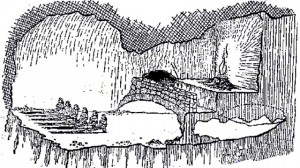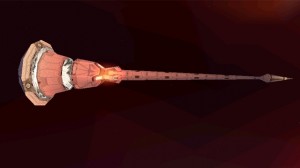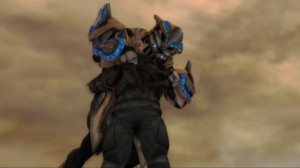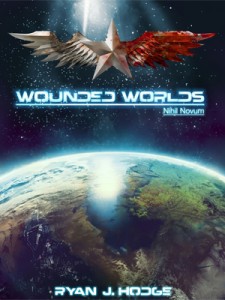-Ryan J. Hodge
For someone who enjoys a great story, is there anything better than a narrative that engages you from the very start? Imagine a world so rich you can almost smell the scents in the air, a delivery so clever it forces you to think in a way you never thought you would. I’m Ryan J. Hodge, author, and I’d like to talk to you about…Video Games.
Yes, Video Games. Those series of ‘bloops’ and blinking lights that –at least a while ago- society had seemed to convince itself had no redeeming qualities whatsoever. In this article series, I’m going to discuss how Donkey Kong, Grand Theft Auto, Call of Duty and even Candy Crush can change the way we tell stories forever.
What Videogames Teach Us About Writing for Religion
Those who have committed to even a cursory study of philosophy have probably been introduced to something known as ‘The Allegory of the Cave”. This mental exercise, proposed by the Greek Philosopher Socrates, supposes that is a group of men were restrained from birth to stare at the wall of a cave; their perception of reality would only be that of the shadows reflected on that wall. It further supposes that if one of those restrained were to be released and shown reality beyond the cave, should he ever return to his comrades, they would actively attempt to silence him –including killing him, if necessary.
In this exercise, we see the germs of what can be described as religious ‘dogma’, and have seen such attitudes reflected throughout history; from Galileo’s arrest to the crucifixion of Christ. But is it true that religion can be boiled down to nothing but a remarkably stubborn misinterpretation of the world around us, and what can videogames do to teach us about it?
In Relic Entertainment’s classic space strategy game, Homeworld (1999), the player is thrust against a faction known as the ‘Kadeshi’. What is interesting about the Kadeshi is that they protect a very specific ‘sacred’ area of space, which they protect with zealous vigor. Later it is revealed that the nebula they defend, ‘the Garden of Kadesh’, is held in religious esteem. However, its lionization is not arbitrary.
As it happens, those who would become the ‘Kadeshi’ were originally part of a convoy that was lost in the nebula. Unable to follow their original group, but well-protected by the nebula’s natural properties; the Kadeshi began preying on all ships straying too close to ‘The Garden’, establishing an entirely space-faring civilization. Over countless generations, they came to worship the nebula; regarding all outsiders as ‘defilers’.
It would be easy to dismiss the Kadeshi as inbred kooks too stupid to realize that this random collection of gases and mineral dust is no more special than any other of the thousands of such collections in the galaxy; but the irony here is that the player behaves just as religiously as the Kadeshi.
The primary mechanic of Homeworld is to build a fleet designed to protect ‘The Mothership’. No vessel, be it a mighty destroyer or heavy cruiser, is more important than the mothership. As such, while a player may see fit to throw away a dozen corvettes in a probing action; he will drop everything to protect the flagship. In a sense, the mothership becomes the player’s ‘sacred ground’, and he will ‘purify’ all transgressors with vigor and gusto.
You lose the mothership; you lose everything. That’s just a fact. So it’s easy to see how it might be expedient for a civilization to treat it as something holy. Such themes are repeated in The 100 (Kass Morgan, 2013-2015) wherein humanity has been sequestered to ‘The Ark’, a massive space station in orbit above a poisoned Earth. On the Ark, all crime –no matter how petty- is a capital crime as, theoretically, anything that might compromise operations or order on the Ark jeopardizes all of humanity.
One might surmise, however, that while developing an entire religion around an important space or object may be considered deluded, it is still nonetheless useful. Better a zealot defend the mothership than someone who’ll abandon it at the first sign of trouble, right?
But what of less critical totems? In William Golding’s Lord of the Flies (1954), we see a group of once presumably ‘well-mannered’ young boys descend into a state of feudal tribalism. While most of the conflict is politically, a great deal of the prosecution of their conflict centers around various artifacts. The ‘conch shell’, at first an arbitrary means to maintain conversational order, becomes a symbol of authority. The ‘glasses’, their most practical means of starting a fire, becomes a symbol of power. Herein we see that items can be assigned worth far beyond their intrinsic value.
Such over-valuation happens in games as well. In the Nintendo 64 adaptation of Goldeneye (Rare, 1997), certain multiplayer modes are designed around the possession of the ‘golden gun’; a weapon that has enough firepower to instantly kill anyone it hits, regardless of location. While it is quite possible to win the multiplayer match without the golden gun; possession and eliminating the possessor of the golden gun are considered to be the primary goals regardless.
Nonetheless, the intrinsic values of items like the glasses and the golden gun are still inarguable (albeit less critical than the mothership or the Ark). Often, however, where religion’s worst excesses lay are areas where the value or nature of certain aspects of creation can be disputed. In the 2001 FPS, Halo: Combat Evolved (Bungie), players find themselves trapped on a strange ‘ring world’ called Halo.
His alien adversaries believe that Halo is a sacred relic ‘whose great winds will blow across the cosmos to send those worthy on a Great Journey’. However, the player understands Halo to be a means to defeat a parasitic race known as The Flood. As it happens, both parties are correct…sort of.
The reality is that Halo is one of many such installations across the galaxy. When activated, the Halo rings will deploy a massive destructive pulse; killing all life in the galaxy. Thus this will both eliminate the flood AND permanently unburden the terrestrial concerns of the galactic populace…just not in the matter than any of parties hoped.
While this makes for an interesting plot twist; the most interesting aspect of the matter is that the Player Character would have willingly sacrificed himself if it meant deploying Halo’s ‘defenses’ at any point before learning of the installation’s true nature. Here we see how even a reasonable and intelligent person can be led into taking drastic action with far-reaching consequences on faith alone.
This idea is perfectly exemplified in the 1900 fantasy classic, The Wonderful Wizard of Oz (L. Frank Baum). In the story, Dorothy is assured by Glinda ‘The Good Witch of the North’ that the ‘Wizard of Oz’ has the power to return Dorothy home. Now what Glinda told Dorothy is true (Oz indeed has a hot air balloon that can take Dorothy home), but the Wizard’s title and stature within Oz convinces Dorothy and her companions that he possesses power far beyond what was explicitly told to her, and thus they embark on a treacherous journey; utterly convinced that their ‘faith’ in the Wizard is well-informed and correct despite being invented whole-cloth.
But many a gamer, himself, has taken on such foolish errands. In Super Mario 64 (Nintendo, 1996), a cryptic message inscribed on the ‘Eternal Star’ reads “L is Real 2041”. With no additional context, many assumed and insisted that this message meant that Luigi (Mario’s brother) was playable in the game and only obtainable after collecting 2041 coins (which was assumed to be the total amount of coins in-game). With no other evidence to support this, many players whiled away countless hours in an attempt to unlock a feature that simply did not exist.
While this does seem ridiculous to the casual observer, similar ‘Easter Eggs’ have been known to exist in video games. There’s even a ‘Doom-like’ FPS feature in Microsoft Excel ’95. Who is to say that there isn’t more to the universe than what we can measure and observe?
In effect, however, every time a player presses, the start button; it’s an exercise in faith. We trust what’s displayed on our screen and what’s told to us in exposition is the truth, and act on this supposed truth. Whether its taking perilous journeys, performing absurdly complicated feats, or killing our ‘enemies’ in droves, a player –with the right motivation- can be made to act gleefully, recklessly, thoughtlessly, and obliviously.
While this article is not meant to debunk or question anyone’s deeply held beliefs; maybe, just maybe, we can learn far more about the nature of faith by picking up a controller on Sunday morning rather than any given ‘good book’ and who knows? It just might make you a better writer.
Ryan J. Hodge is a science fiction author and is a Games Industry veteran. His latest book, Wounded Worlds: Nihil Novum, is available now for eBook & Paperback.
You can now follow Ryan on Twitter @RJHodgeAuthor









